
In the River KATSURA --Vol.100--
The Opposite Bank
The holiday week of early May in 1986 passed. Now the River Katsura was my main target, as I had planned in the previous year. I fished there in the evening as often as possible on my way back from daytime fishing anywhere. Different from the previous year, the weather was mild and the breeze blew in the evening. Well, fishing conditions were very good. The fish made a lot of rises at the right time and place. Great Sedge, I completed 2 years before, made great performance from the start of the season and almost all yamame trout bit it after rise without fail. But my lucky days never lasted long. In the beginning of June the rise of yamame trout remarkably decreased. I wondered why. The fish number decreased or they moved somewhere? May passed before I got an answer.
A very fat amago trout. This kind of trout has a higher body than yamame trout. Great Sedge caught a lot of yamame trout from the beginning of the season.
One evening of very early June, I walked down to the bank from a new descending spot at the lower reaches of the hospital. The river had medium water. It was hot and humid although comfortable breeze blew now and then. 4 fishermen were standing near the head of the pool downstream with their rods under their arms. Each bank had 2 fishermen although the evening rise seemed to start more than 1 hour later.
In those days a lot of fly fishermen made it their practice to fish the evening rise, apart from daytime fishing. It was well known that the evening rise was the climax of the day to get big fish especially in a village river with an open view. Then some of them became more and more eager to plant themselves at the main spots and wait for several hours.
I wanted to secure my casting place at the evening rise but not wait for many hours at the target point without any guarantee of rises. Instead, I usually went upstream. I mean that if I find a good-looking spot, I will start to fish. And if some spots draw my attention, I will mark them.
There was a water-draining mouth some hundreds metres upstream of my descending spot. I had to cross the fast-flowing river twice to get there, where a little higher water would be dangerous. Fortunately, the water level was not so high.

A brown trout lost the stamina and broke the surface.
Aiming for big fish, I had Premiere of 9ft. 1in. and #7 fly line. Super Tech Leader 9ft. 2X, whose tip had been slightly cut, was put to it and size 4 Dunkeld was put to the leader. Super Tech Leader was completed in 1985. Checking carefully many points, I got to the water-draining mouth. Season, weather, water, everything was perfect. Something is going to happen today! It was one of the rarest days in my long fishing life when I firmly believed so.
The sunshine was poor around the water-draining mouth due to both soaring banks. It got dark 10 minutes earlier in the evening than the lower reaches with an open view. It meant that sedges started flying and rises started earlier. Actually, several sedges had already been flying. Above my head, more sedges were flying along the cliff. Looking around carefully, I walked downstream very slowly.

Even a strong brown trout became calm after it lost the stamina.
A White Flower
The river was flowing between the narrower banks more heavily. There was an attractive deep pool just downstream. I carefully crossed the river to the left bank. The deep pool was less than 10m wide and a giant rock like a roof on the right bank spread over the deep pool. It was already dark inside. Sedges flying from downstream were sucked into the darkness. It was common scenery here but I never saw rises or got a bite here for some reason. I quietly left there without casting and walked to several good points downstream, where I had got good catch and now my attention was drawn.But something told me to turn around and I saw a white flower in the darkness under the giant rock. Half doubting my eyes, I looked at it again. A white flower appeared again.
I got excited. My heart was beating so fast. A rise! A good-sized fish is trying to bite some sedges. I stooped down and returned to the deep pool. I stood in front of the rise. It was only 7 or 8m away. I drew the line from the reel. The rattling sound calmed me. A big splash in front of me! I let go of Dunkeld from my left hand. Kneeling down, I made a roll cast to send the fly far under the overhanging rock. Another roll cast and another. A splash just upstream! At the next moment I cast the fly there. Again and again. No response.
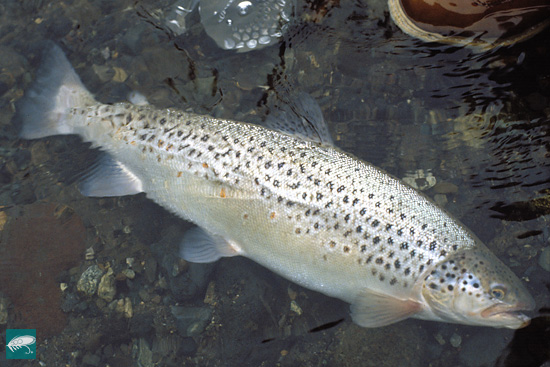
Brown trout, with parr of which were stocked the river in the same year, often had similar size, looks and fatness.
The surface split 2m downstream. The fish had no sign to come from under the giant rock. As far as I fished here the fly flowed downstream immediately it settled on the surface. Probably the fish recognized it as a scum or rubbish because he was absorbed in sedge. I quietly walked backwards to go upstream. From here the rise was seen diagonally downstream of me. In addition, open space behind me set me free from making roll cast. I drew another 2m of the line and swung the rod to the left to make the line extend into the darkness under the giant rock. At the same time I slightly raised the rod tip and tightened the line as soon as it settled on the surface.
One moment later a big shock ran down through the rod to my whole body. I felt a strong pull with thud which guaranteed unmistakable hooking. Immediately I raised the rod, something like an animal rushed deep into the darkness. I left the bank slowly and came to the side of the fish. Then the fish slowly began to move upstream on the bottom. Whenever it swung its body, the rod bent like an arc and the rod tip almost stuck into the surface. It was too heavy to be a yamame trout. Not a rainbow trout either, which would run more. What fish?
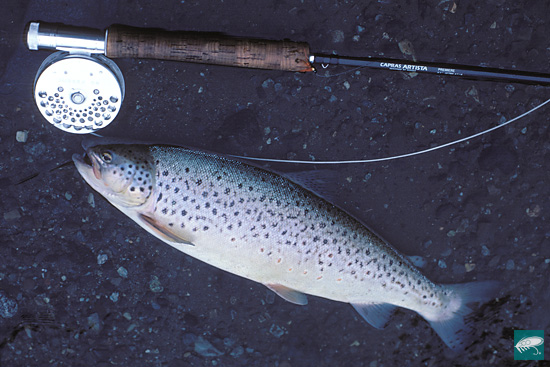
Dunkeld was very effective to fish brown trout in that year.
I wanted to see it immediately. But I could not pick it up on the surface so soon. On the contrary, I worried that the leader would scrub the bottom whenever the fish moved on the bottom. More than 5 minutes passed. The fish suddenly became calm. I slowly and carefully pulled it away from the opposite bank and guided it to the shallow current on this side. It was dark under the rock but still light under my feet. Finally a beige body with black stars appeared in the twilight. A brown trout!
I grabbed the leader and guided the fish to the waterside. The fish became so calm now that I could not believe it had been strong enough to keep the rod bending. It had a small head and a high body. Its face showed it was gentle and well-bred. It was almost 50cm long. Probably it was 2 years old.
There was something in common about brown-trout fishing. They were caught when a lot of sedges were hatched. The spot was close to the opposite bank where the heart of stream flowed and the bank quite often overhung into the water. There was an obstacle over the point, like a bush or some overhanging branches, in many cases. In that kind of spots, including Oshino, I caught a lot of brown trout. I can say that it was a favourite point of brown trout.
-- To be continued --
- NET SHOP INFORMATION
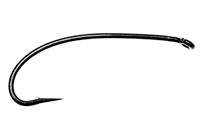
SL6 Black Spey Hooks
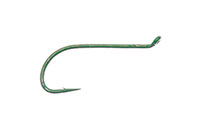
DU3 Limerick Spinner Hooks
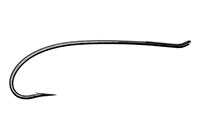
SL4 Single Bartleet Hooks
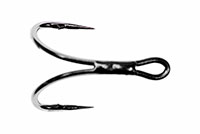
XD1 Tube Fly Double Hooks
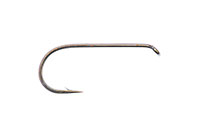
DD2 Flat Perfect Hooks
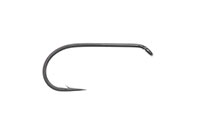
DD1 Black Terrestrial Hooks
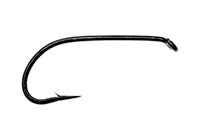
TD4 Old Limerick Wet Hooks
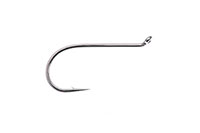
DU1 Silver May Hooks
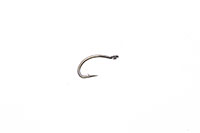
MU1 Flat Midge Hooks
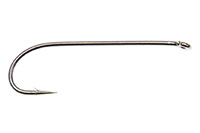
LD3 Long Limerick Hooks
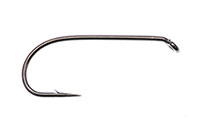
TD2 Summer Sproat Hooks
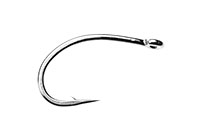
XS1 Tube Single Silver Hooks
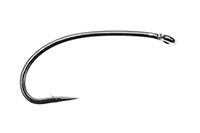
TD6 Siver Sedge Hooks

SL5 Black Spey Hooks

DU3 Limerick Spinner Hooks
- TROPHY CLUB
- FLY SHOW
- EXHIBITION
- MASTERS`
- FLY DRESSING CONTEST Archives
- TRAVELLER Archives
- TACKLE IMPRESSIONS Archives
- ANGLERS` PHOTO GALLERY Archives
- ----------------------------------------------
- トロフィークラブ
- フライショー
- エキシビション
- マスターズ
- フライドレッシング・コンテスト・アーカイヴ
- トラヴェラー・アーカイヴ
- タックル・インプレッション・アーカイヴ
- アングラーズ・フォトギャラリー・アーカイヴ
株式会社サワダ 185-0021 東京都国分寺市南町3-13-4
SAWADA'S INC. 3-13-4 Minamicho, Kokubunji, Tokyo 185-0021, Japan
写真・ドキュメントの無断転載を禁じます。
All the images and documents found on this site are owned by Ken Sawada and may not be used without permission.
But, link to this site is FREE.
Copyright © 2000 - 2025 SAWADA'S INC.. All rights reserved.
SAWADA'S INC. 3-13-4 Minamicho, Kokubunji, Tokyo 185-0021, Japan
写真・ドキュメントの無断転載を禁じます。
All the images and documents found on this site are owned by Ken Sawada and may not be used without permission.
But, link to this site is FREE.
Copyright © 2000 - 2025 SAWADA'S INC.. All rights reserved.
